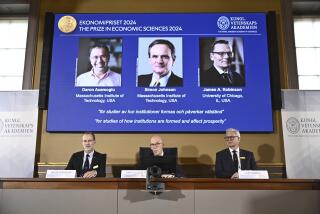3 Share Nobel for Discoveries About the Mind
Two Americans and a Swede whose research explained how memory works and laid the foundation for the development of Prozac, other antidepressants and L-dopa, the most widely used Parkinson’s drug, have been awarded the 2000 Nobel Prize in physiology or medicine.
The pioneering researchers discovered one of the key ways in which brain cells send messages to one another, through the use of a neurotransmitter called dopamine. This process, called slow synaptic transmission, also regulates the faster transmissions that control speech and muscle movement.
By understanding how messages are sent between cells when the brain is functioning normally, they were able to point the way to the use of drugs to control malfunctions. The discoveries might lead to new drugs for Alzheimer’s disease.
Biochemist Paul Greengard, 74, of Rockefeller University in New York City; Dr. Eric Kandel, 70, of Columbia University in New York; and Dr. Arvid Carlsson, 77, of the University of Goteborg in Sweden will share the $915,000 prize.
Their research provided “tremendous leaps in our understanding of how the human mind learns and remembers, paving the way to advances in treating a host of neurological and psychiatric disorders,” said Dr. Story Landis of the National Institute of Neurological Disorders and Stroke.
Carlsson, the first Swede to win a Nobel since 1982, was the first to learn of this year’s prize, announced in Stockholm in the middle of the American night. “I was delighted,” he told Reuters. He admitted that he had long thought about the possibility of winning the prestigious prize for his five decades of work.
“That has occurred to me,” he said. He added that his wife would decide what to do with the money. “She is the one who makes such decisions.”
Greengard was given a two-minute standing ovation when he appeared at a news conference at Rockefeller University. “I am naturally thrilled and particularly moved,” he said. “It’s just a wonderful feeling.”
Greengard, who claimed he wasn’t expecting to win the Nobel, said he would use his share of the prize money to help fund another prize, a 2-year-old award at Rockefeller established to honor outstanding women in biomedical research.
Kandel, born in Vienna, told a news conference that he came to New York in 1939 to escape Adolf Hitler. He noted that his interest in memory had been stimulated by the events surrounding World War II.
“We are who we are because of what we learn and what we remember, the traumatic experiences such as those that I experienced in Vienna and the more horrible experiences that others had who had more difficult times than I did, permanently scarring their lives,” he said. “To understand what happens to the brain when that occurs, I think, is just a wonderful problem.”
Carlsson’s contributions began in the 1950s when he explored the biology of a brain chemical called dopamine. At the time, dopamine was thought to be little more than a precursor of a more important brain hormone called noradrenaline.
His work showed that dopamine was an important hormone in its own right and that it was concentrated in a region of the brain, called the basal ganglia, that controls the motion of limbs.
Working with mice, he discovered that blocking dopamine production caused the animals to lose control of their limbs, but that control could be restored by administering L-dopa. He realized that the symptoms displayed by the mice were similar to those of Parkinson’s victims, and later research soon showed that humans with that disease also had low levels of dopamine in their basal ganglia.
“Parkinson’s used to be a disease of which people would die a horrible death, often by suffocation,” said Ralf Patterson, chairman of the Nobel committee at the Karolinska Institutet, which selected the winners. Today, he added, there are millions of people who have their symptoms controlled with L-dopa. “That’s almost a magical thing.”
Carlsson also showed that antipsychotic drugs, which are used primarily against schizophrenia, work by blocking dopamine receptors. His research laid the groundwork for development of the family of drugs called selective serotonin uptake inhibitors. These drugs, including Prozac, are used in treating depression.
“Dopamine has turned out, of all the neurotransmitters, to be the most involved in common human illnesses, including Parkinson’s, manic-depressive illness and schizophrenia,” said Dr. Steven Hyman of the National Institute of Mental Health.
The brain mechanisms the three researchers studied, he added, “are going to be targets for development of better treatments for schizophrenia, for mood disorders, for Parkinson’s, for drug addiction and many other illnesses.”
Greengard was honored for his discoveries of how dopamine and other neurotransmitters exert their effects at the synapses, the points of contact between individual brain cells. He found that they do this through a chemical reaction called protein phosphorylation.
He showed that when dopamine binds to a receptor in a nerve cell, it causes a phosphate group to be coupled to a specific protein in such a way that the form and function of the protein are altered. That alteration, in turn, triggers a cascade of other chemical changes that make it possible for the nerve cell to transmit an electrical signal along its length.
“We worked on this for many years without competition,” Greengard joked Monday, “because people thought we were insane.”
He has also demonstrated that many effects--both therapeutic and toxic--of several classes of common antipsychotic, hallucinogenic and antidepressant drugs can be explained in terms of how they interfere with this series of chemical reactions.
Kandel has also studied the role of phosphorylation of proteins at the synapses, focusing on how it affects learning and memory.
He originally wanted to study learning in mammals, but concluded that the large number of brain cells made the process too complex. He turned instead to the sea slug, Aplysia, which has about 20,000 nerve cells, compared to the 100 billion in the human brain.
He demonstrated that short-term learning is controlled by the phosphorylation of proteins called ion channels at the synapses. These channels let specific ions, such as sodium, into and out of the cells. Long-term memory is produced by more permanent changes in these proteins.
In effect, he concluded that the synapses are the actual storage sites for memories. He has subsequently replicated the work in mice, and researchers are confident that the same chemical processes also occur in humans.
Tim Bliss, head of neuroscience at the National Institute for Medical Research in London, said Kandel’s work could lead to new treatments for Alzheimer’s and other conditions involving memory loss.
“It’s a very major piece of work and he’s been an outstanding leader in the field for many years,” Bliss said. “He identified the physical embodiment of learning and memory in the brain.”
(BEGIN TEXT OF INFOBOX / INFOGRAPHIC)
How Brain Cells Converse
The three Nobel winners shared the prestigious award for studies on how messages move around the nervous system. Their work was important in developing drugs to treat diseases such as schizophrenia, Parkinson’s and depression.
*
Source: Nobel Assembly at the Karolinska Institutet






